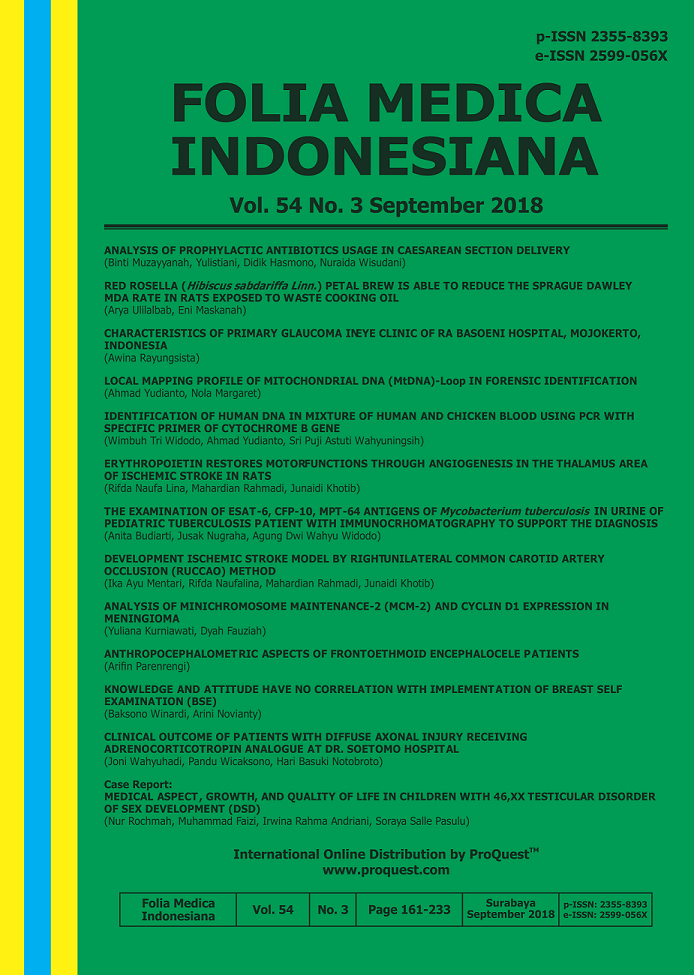Main Article Content
Abstract
Keywords
Article Details
References
- Bruno A, Kaelin DL, Yilmaz EY (2000). The Subacute Stroke Patient: hours 6 to 72 after stroke onset. In Cohen SN. Management of Ischemic Stroke. New York, McGraw-Hill, p 53-87
- Deb P, Sharma S, Hassan KM (2009). Pathophy-siologic mechanisms of acute ischemic stroke: An overview with emphasis on therapeutic significance beyond thrombolysis. Pathophysiology 17, 197-218
- Gandin C, Widman C, Lazdunski M, et al (2016). MLC901 favors angiogenesis and associated reco-very after ischemic stroke in mice. Cerebrovascular Disease 42,139-154
- Gonzalez RG, Hirsch JA, Lev MH et al (2011). Acute ischemic stroke. London New York, Springer Heidel-berg Dordrecht
- Hacke W, Kaste M, Bogousslavsky J, et al (2003). Ischemic stroke prophylaxis and treatment. European Stroke Initiative Recommendations
- Hellewell SC, Yan EB, Alwis DS, et al (2013). Erythro-poietin improves motor and cognitive deficit, axonal pathology, and neuroinflammation in a combined model of diffuse traumatic brain injury and hypoxia, in association with upregulation of the erythropoietin receptor. Journal of Neuroinflammation 10, 156
- Hoke, A. 2006. Erythropoietin and The Nervous System. John Hopkins University, Springer, p 25-101
- Hua Y, Schallert T, Keep RF, et al (2002). Behavioral Tests After Intracerebral Hemorrhage in the Rat. Stroke 33, 2478-2484
- Jin R, Yang G, Li G (2010). Inflammatory Mechanisms in Ischemic Stroke: Role of Inflammatory Cells. Journal of Leucocyte Biology 87
- Ovbiagele B, Huynh MN (2011). Stroke Epidemiology: Advancing Our Understanding of Disease Mechanism and Therapy. The American Society for Experimental NeuroTherapeutics 8, 319-329
- Park SY, Marasini S, Kim GH, et al (2014). A Method for Generate a Mouse Model of Stroke. Experimental Neurobiology 23 (1), 104-114
- Pun PB, Lu J, Moochhala S (2009). Involvement of ROS in BBB dysfunction. Free Radical Research 43, 348-364
- Rabie T, Marti HH (2008). Brain Protection by Erythro-poietin: A Manifold Task. Physiology 23, 263-274
- Ribatti D, Vacca A, Roccaro AM, et al (2003). Erythro-poietin as an angiogenic factor. European Journal of Clinical Investigation, 891-896
- Siren AL, Fratelli M, Brines M, et al (2001). Erythro-poietin prevents neuronal apoptosis after cerebral ischemia and metabolic stress. Proceedings of the National Academy of Sciences USA 98, 4044-4049
- Vikman, P, Ansar S, Henriksson M, et al (2007). Cere-bral ischemia induces transcription of inflammatory and extracellular-matrix-related genes in rat cerebral arteries. Experimental Brain Research 183, 499- 510
- Wang L, Chopp M, Gregg SR, et al (2008). Neural pro-genitor cells treated with EPO induce angiogenesis through the production of VEGF. Journal of Cerebral Blood Flow and Metabolism 28, 1361-1368
- Wang L, Zhang Z, Wang Y, et al (2004). Treatment of stroke with erythropoietin enhances neurogenesis and angiogenesis and improves neurological function in rats. Stroke 35, 1732-1737
References
Bruno A, Kaelin DL, Yilmaz EY (2000). The Subacute Stroke Patient: hours 6 to 72 after stroke onset. In Cohen SN. Management of Ischemic Stroke. New York, McGraw-Hill, p 53-87
Deb P, Sharma S, Hassan KM (2009). Pathophy-siologic mechanisms of acute ischemic stroke: An overview with emphasis on therapeutic significance beyond thrombolysis. Pathophysiology 17, 197-218
Gandin C, Widman C, Lazdunski M, et al (2016). MLC901 favors angiogenesis and associated reco-very after ischemic stroke in mice. Cerebrovascular Disease 42,139-154
Gonzalez RG, Hirsch JA, Lev MH et al (2011). Acute ischemic stroke. London New York, Springer Heidel-berg Dordrecht
Hacke W, Kaste M, Bogousslavsky J, et al (2003). Ischemic stroke prophylaxis and treatment. European Stroke Initiative Recommendations
Hellewell SC, Yan EB, Alwis DS, et al (2013). Erythro-poietin improves motor and cognitive deficit, axonal pathology, and neuroinflammation in a combined model of diffuse traumatic brain injury and hypoxia, in association with upregulation of the erythropoietin receptor. Journal of Neuroinflammation 10, 156
Hoke, A. 2006. Erythropoietin and The Nervous System. John Hopkins University, Springer, p 25-101
Hua Y, Schallert T, Keep RF, et al (2002). Behavioral Tests After Intracerebral Hemorrhage in the Rat. Stroke 33, 2478-2484
Jin R, Yang G, Li G (2010). Inflammatory Mechanisms in Ischemic Stroke: Role of Inflammatory Cells. Journal of Leucocyte Biology 87
Ovbiagele B, Huynh MN (2011). Stroke Epidemiology: Advancing Our Understanding of Disease Mechanism and Therapy. The American Society for Experimental NeuroTherapeutics 8, 319-329
Park SY, Marasini S, Kim GH, et al (2014). A Method for Generate a Mouse Model of Stroke. Experimental Neurobiology 23 (1), 104-114
Pun PB, Lu J, Moochhala S (2009). Involvement of ROS in BBB dysfunction. Free Radical Research 43, 348-364
Rabie T, Marti HH (2008). Brain Protection by Erythro-poietin: A Manifold Task. Physiology 23, 263-274
Ribatti D, Vacca A, Roccaro AM, et al (2003). Erythro-poietin as an angiogenic factor. European Journal of Clinical Investigation, 891-896
Siren AL, Fratelli M, Brines M, et al (2001). Erythro-poietin prevents neuronal apoptosis after cerebral ischemia and metabolic stress. Proceedings of the National Academy of Sciences USA 98, 4044-4049
Vikman, P, Ansar S, Henriksson M, et al (2007). Cere-bral ischemia induces transcription of inflammatory and extracellular-matrix-related genes in rat cerebral arteries. Experimental Brain Research 183, 499- 510
Wang L, Chopp M, Gregg SR, et al (2008). Neural pro-genitor cells treated with EPO induce angiogenesis through the production of VEGF. Journal of Cerebral Blood Flow and Metabolism 28, 1361-1368
Wang L, Zhang Z, Wang Y, et al (2004). Treatment of stroke with erythropoietin enhances neurogenesis and angiogenesis and improves neurological function in rats. Stroke 35, 1732-1737
